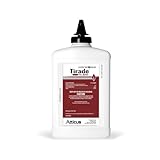A swarm of yellow jackets can put a damper on a picnic or other outdoor plans. And if they invade your yard, or worse, your house, they become a safety hazard and a huge concern.
So, how to get rid of yellow jackets? You first need to know what their nest looks like and where it’s located. Then, you can choose to apply a yellowjacket killer spray, insecticide dust, repellents (both natural and commercial), or ammonia. Alternatively, you can also try setting up a trap or nest decoy before using the aforementioned products.
Getting rid of yellow jackets starts with understanding what keeps them away. Read on as we discuss where they live, how to find the nests, what to do if you get bitten, and go over ways to kill them.
What Is a Yellow Jacket?
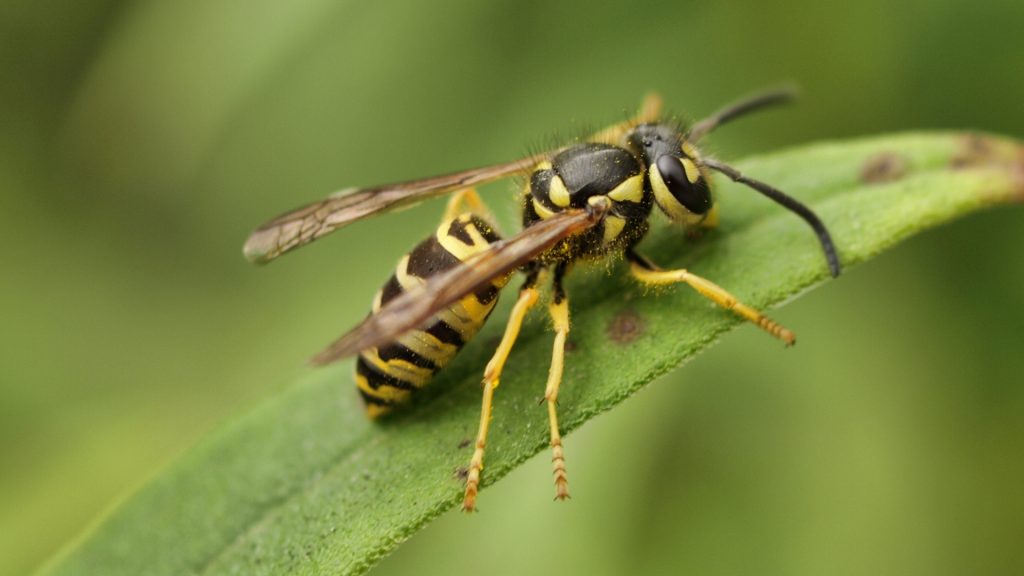
Yellow jackets are carnivorous and social wasps known for their fierce stings, which they use to paralyze their prey or defend their nests. They can be found worldwide. In the United States, they can be found in every state, but yellow jackets are most prevalent in the southeast.
In the spring and early summer, yellow jackets forage for insects to feed the larvae. As they grow older, their diets change, and they seek out sugar at the same time that people are spending more time picnicking
What Does a Yellow Jacket Look Like?
Although yellow jackets don’t look like honeybees, people sometimes confuse the two. Yellow jackets have yellow and white markings as well as white or yellow hair on their faces, but they aren’t “fuzzy” like bees.
Although most yellow jackets are yellow and black, some species have red markings and others are white and black. Also, since yellow jackets don’t carry pollen, their hind legs aren’t hairy like a bee’s.
How Big Are Yellow Jackets?
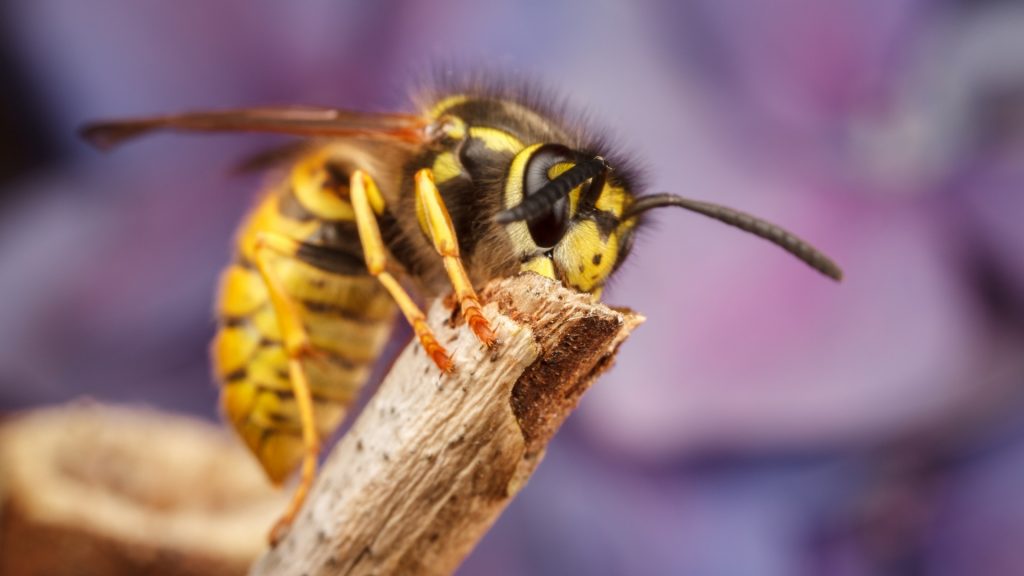
Yellow jackets are similar in size to bees, which is one reason people sometimes confuse the two. Adults are ½ inches long and nearly hairless while queens are ¾ inches long. Yellow jacket worker bees weigh 50 to 60 grams on average, which is half of a worker bee’s weight.
Even though they’re small, yellow jackets can build enormous nests. In the last few years, several nests the size of a car have been spotted in southeastern states with mild winters.
Types of Yellow Jackets
Both yellow jackets and hornets are members of the Vespinae or true wasps subfamily. Although there are 4,000 wasp species in the United States, most are solitary insects that prey on arthropods.
Only several yellow jacket species are considered dangerous. These include the Eastern (Vespula maculifrons), Southern (V. squamosa), and Western yellow jackets (V. pensylvanica), which are native to the United States, and German yellow jackets (V. germanica), which were introduced in the 1970s.
How Long Do Yellow Jackets Live?
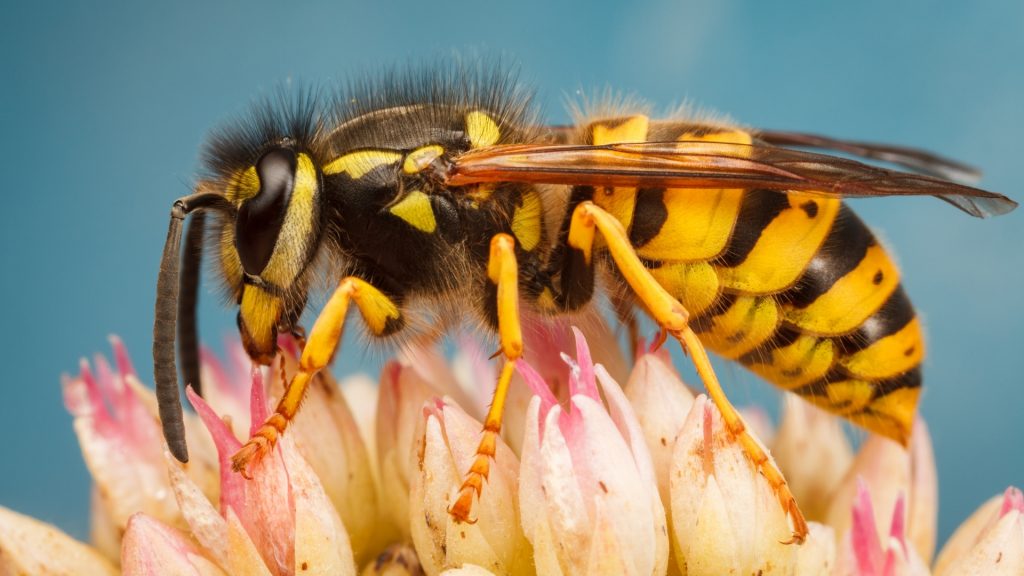
A yellow jacket colony dies out in the winter, usually when temperatures are consistently under 45°F except for young yellow jacket queens. The young queen survives by finding a shelter location, such as in a decaying tree stump, to hibernate.
Then, in the early spring, the queens come out of hibernation and feed on nectar sources, such as flowers, and prey on arthropods. It’s only later when the nest has been built that yellow jackets seek out other food.
What Do Yellow Jackets Eat?

Yellow jackets feed on flower nectar and other sources of sugar for energy. However, their larvae need protein, so yellow jackets hunt insects and other protein sources to take back to their nests. They’ll travel up to a mile from their nests to forage for food.
Since yellow jackets eat insects, they’re sometimes considered beneficial insects as they can control pest populations. Most homeowners, however, feel the dangers of getting stung outweigh any potential benefits.
Related: What Do Wasps Eat? | Information & Facts
Yellow Jacket Nest
The chances are excellent that you’ll spot a yellow jacket before you find its nest. But what do their nests look like, and where can you find them?
What Does a Yellow Jacket Nest Look Like?
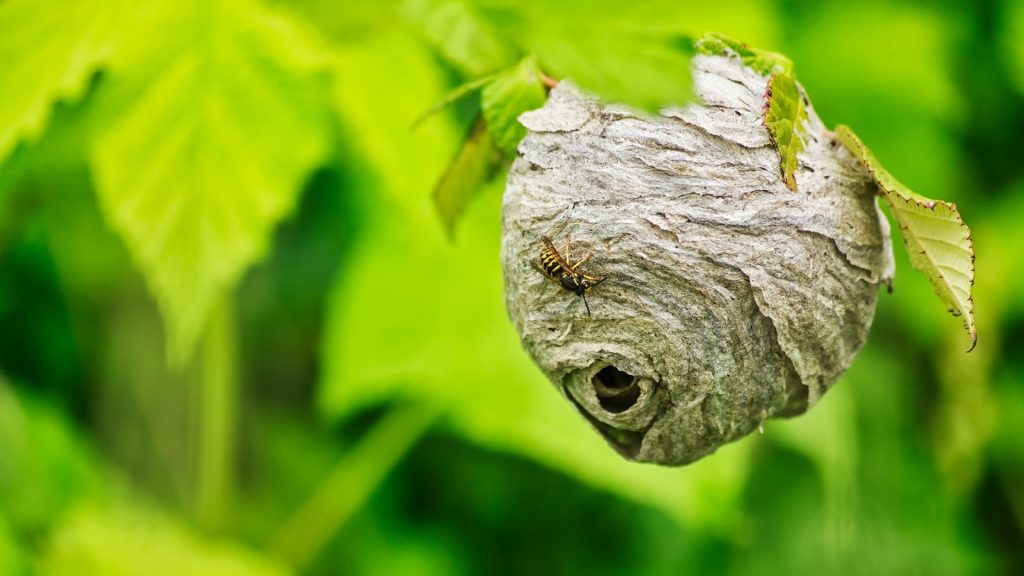
A yellow jacket nest is built from wood fibers which the queen chews and mixes with saliva to make a paper-like structure. The queen will build the initial nest, consisting of 25 to 40 small cells surrounded by a smooth, paper-like envelope.
Once the workers emerge, they take over the job of building the nest and foraging for food while the queen remains in the nest and lays eggs. Yellow jacket nests typically have a single opening and resemble an oddly shaped paper mache project.
Related: Hornet Nest vs. Wasp Nest | Similarities, Differences, and How to Get Rid of Them
Where Do Yellow Jackets Nest?
Yellow jackets prefer to nest underground, usually in holes dug by small rodents such as squirrels, moles, or groundhogs. Not only do they not have to dig a nest, but they’ll find insects to feed on.
If they cannot find underground nests, they’ll look for trees and hollow logs. They’ll also build nests in attics, on eaves, or if there’s easy access, inside house walls.
How To Find a Yellow Jacket Nest?
Spotting a yellow jacket nest can be difficult, especially if they’ve built it underground, in dense shrubbery, or inside an attic or house walls. In addition, yellow jackets could’ve built several nests in an area, or a nest can be several hundred feet away.
To find a yellow jacket nest, let the yellow jackets guide you to it, and use these tips to help you locate a nest:
- Look for them on a sunny day, preferably in the middle of the day. The late afternoon might help you spot them flying in a straight line to their nest.
- Yellow jacket nests are often underground, so be careful where you step.
- You could come across a group of yellow jackets guarding a nest opening.
- Yellow jackets often build more than one nest, so if you spot one, continue searching for others.
- Use protein or sugary foods as bait and follow them to their nest (or nests).
Are Yellow Jackets Dangerous?
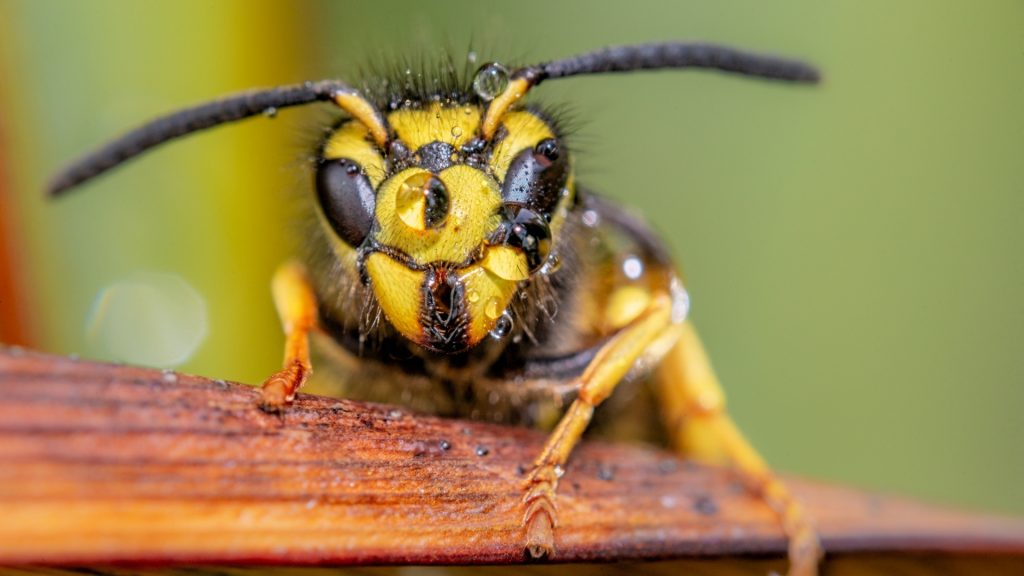
Yellow jackets are dangerous insects known for defending their nests much more actively than paper wasps and honeybees. A swarm of yellow jackets is a sign they feel their nest is being threatened. But yellow jackets often sting for no reason, even if they haven’t been disturbed. Once one stings you, others are not far behind.
Are Yellow Jackets Aggressive?
Yellow jackets are aggressive because they’re social animals that work together for a common cause. Once a single insect feels the nest is being threatened, the entire colony gets ready to attack. Among insects, they’re some of the most strongly social, so you won’t have one or two yellow jackets out to get you but the whole nest.
Do Yellow Jackets Sting?
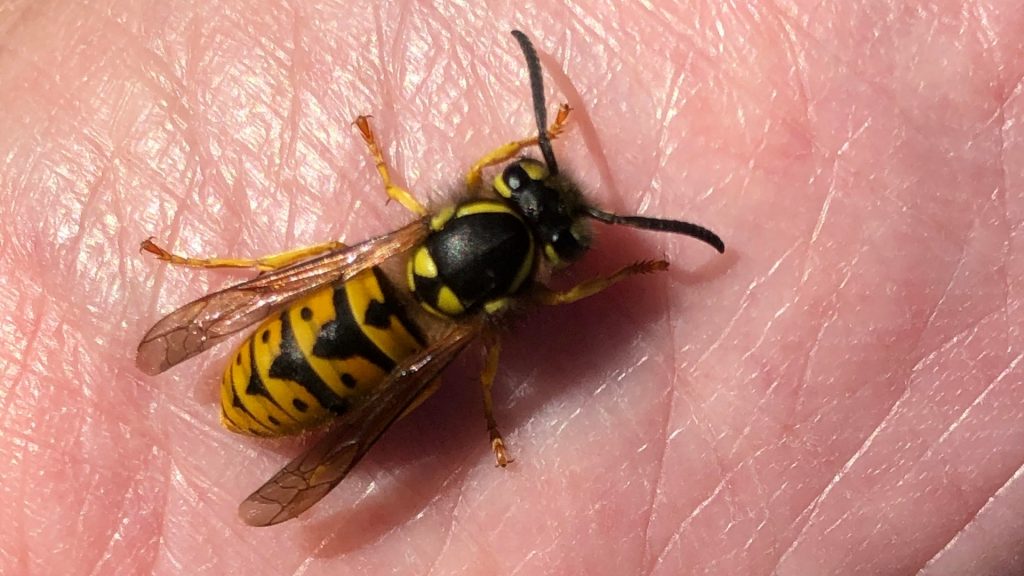
Honeybees lose their stingers when they attack, but yellow jackets have smooth stingers and can sting repeatedly. However, they inject less venom in the second sting.
The poison in a yellow jacket’s sting can cause immediate pain followed by inflammation or redness, which can last for several hours. Some people experience warmth and itching.
Not only that, yellow jackets bite your skin to get a better grip before they sink their stingers in, which is another reason their bites are painful.
What Does a Yellow Jacket Sting Look Like?

The area around the sting will swell and turn red. The area can also become quite itchy. Massive swelling is a serious symptom that requires urgent medical care.
Occasionally a yellow jacket sting can become infected. If there are red streaks, pus, or the swelling doesn’t reduce within a few days, you should have a doctor take a look at it.
Do Yellow Jackets Die After They Sting?
Yellow jackets don’t die after they sting. Their stingers aren’t jagged, so it remains attached when they pull it out. When the honeybee loses its stinger, it loses not only the stinger but enough of its digestive tract to kill it.
Allergic Reaction to Yellow Jacket Sting
Some people have allergic reactions to yellow jacket stings. The following symptoms require medical attention:
- Breathing difficulties, coughing or wheezing, or difficulty swallowing
- Vomiting or diarrhea
- Feeling dizzy or lightheaded
Call 911 if these symptoms occur. Additionally, help those experiencing the above symptoms lie on their back, raise their feet, and cover them with a blanket. You should also seek medical help if you’ve been stung in the mouth or throat or been stung more than 10 times.
Related: What to Do With a Wasp Sting? | All You Need to Know!
What Attracts Yellow Jackets?
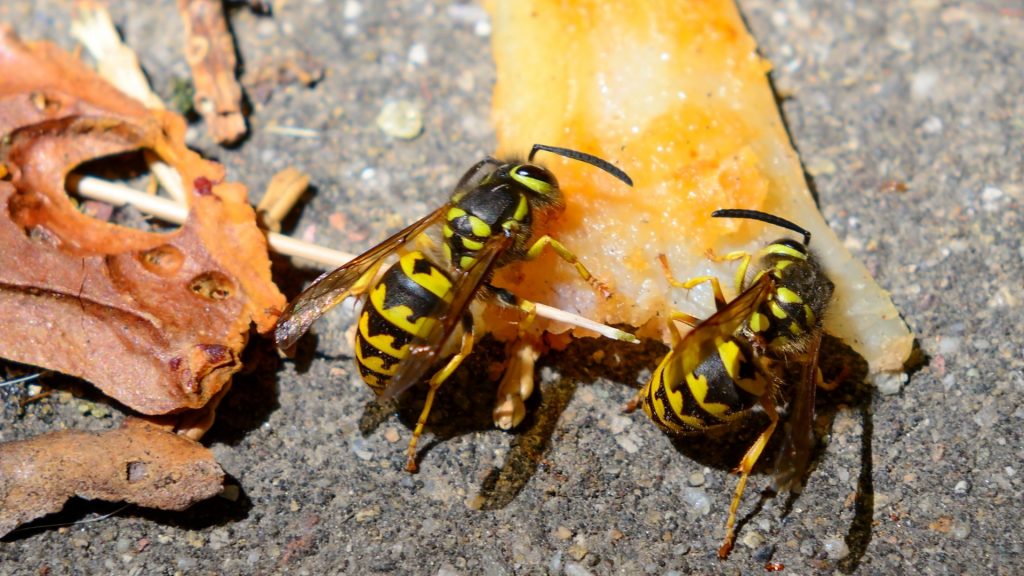
Sugary foods and drinks attract yellow jackets. In the wild, they get sugar from nectar and protein from arthropods. So, if humans leave sweet treats out, they come to scavenge. This is why they can often be found at picnic facilities, especially those with open garbage cans.
Even if you keep sugary food and drinks inside and always keep your trash cans securely closed, yellow jackets might still show up in your yard. They’ll be attracted to yards with overripe fruit, hummingbird feeders, or pet food kept outside, along with the centipedes and beetles in the ground.
Yellow jackets are also attracted to bright colors and floral perfumes, so if you have a yellow jacket problem, wear plain clothes and avoid perfumes until they’re gone. Finally, if you kill a yellow jacket, don’t be surprised if others show up because as it dies, it releases pheromones that alert other colony members.
How To Kill Yellow Jackets? Step by Step Instructions
To kill yellow jackets, you need to do the following:
- Determine where they’re coming from.
- Decide whether you want to get rid of them.
- Come up with a plan for how to keep them from returning.
Since many of the instructions are location-specific, the rest of the guide will help you tackle different situations. You’ll also get a few recommendations for products that might help you get rid of the aggressive yellow jackets.
Getting Rid of Yellow Jackets and Their Nests in Some Specific Places
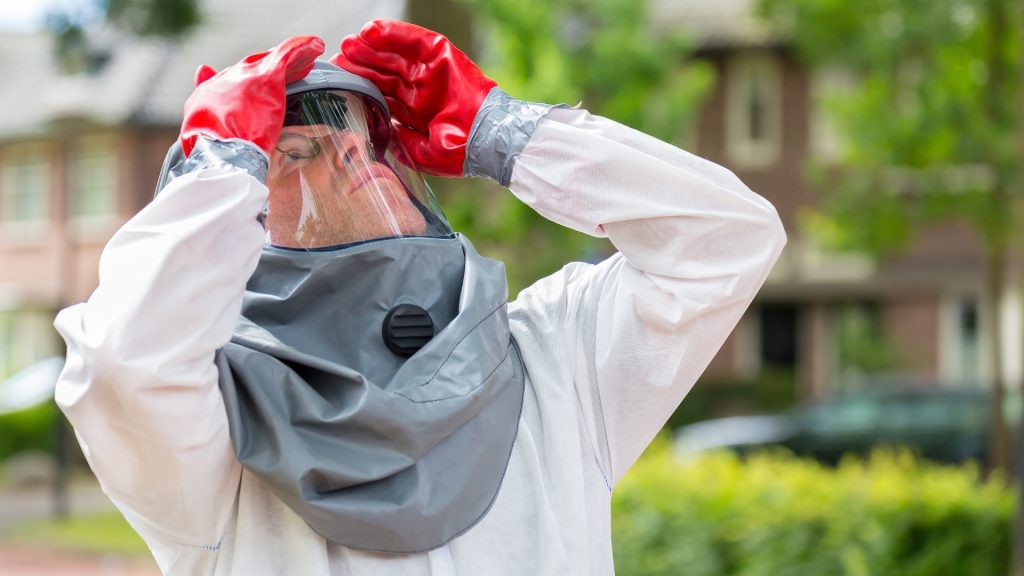
The best way to get rid of yellow jackets and their nests depends on where they are. Strategies for killing them vary from what to do with the nests to how to deal with individual yellow jackets in the house.
The following sections will give instructions and guidelines for dealing with the problem in different situations:
How To Get Rid of Yellow Jacket Nest?
Killing individual yellow jackets won’t solve a yellow jacket problem. But once you locate the yellow jacket nest, you can go about getting rid of them.
To get rid of yellow jackets nest, follow these steps:
- Put on protective clothing, such as long sleeves and gloves, as the chances of getting bitten are greater. To avoid having yellow jackets fly under your clothes, tape the sleeves to your skin. In addition, wear a hat and face veil.
- Use a wasp and hornet spray that is labeled either “quick knockdown” or “quick freeze.”
- Begin spraying in a fanning motion as you approach the nest.
- As you get closer, spray directly into the nest’s entrance.
- Check for activity the next day and reapply if needed.
How To Get Rid of Yellow Jackets in the Ground?
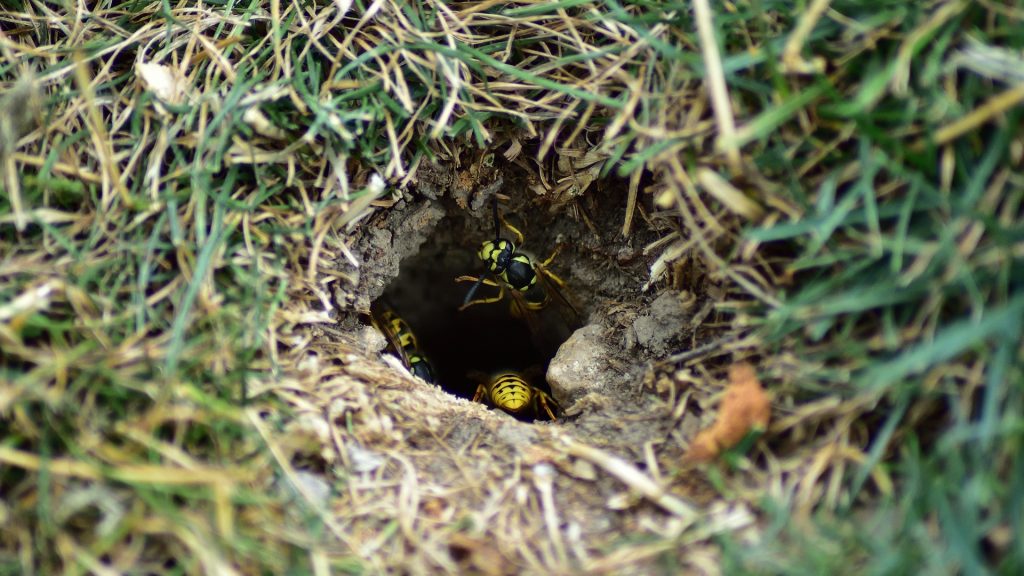
To get rid of yellow jackets in the ground, follow these steps:
- Use a yellow jacket control aerosol product that contains pyrethrum. The pyrethrum creates a gas that fills the nest and kills the yellow jackets.
- Wait until sundown so that the foragers have reentered the nest. Avoid shining a light in the nest as that might cause yellow jackets to fly out.
- Yellow jackets cannot see red, so if you must use a flashlight, cover it with red cellophane.
- Apply an insecticide. The following products are recommended:
Sale 1Atticus Tirade 1% Dust Insecticide (1.25 lb) - Ready-to-Use Insect Killer - Indoor and Outdoor Control of Ants, Bees, Wasps, Hornets, Cockroaches and Many Other pests
- POWERFUL BROAD-SPECTRUM CONTROL: Tirade 1% Dust contains...
- READY TO USE + EASY TO APPLY: Control insects without the hassle...
- KILL 50+ HOUSEHOLD INSECTS: Wipe out common household insects...
- ONE PRODUCT FOR INDOOR + OUTDOOR USE: Tirade 1% Dust may be used...
- NO STAINS, NO STRONG SCENTS: Tirade 1% Dust is low-odor and...
Sale 2Delta Dust Multi Use Pest Control Insecticide Dust, 1 LB- Delta Dust Bed Bug Insecticide - 1 lb.
- Yield: 1 lb. of Delta Dust covers about 2,000 sq.ft.
- Target Pest: Ants, Bed Bugs, Boxelder Bugs, Cockroaches,...
- Active Ingredient: Deltamethrin, 0.05%
- Cannot ship to NY or CT.
- Lastly, check the nest in the succeeding days. Yellow jackets that are deep in the nest may survive, and the nest can become active again. If yellow jacket activity is still present, spray again and top with insecticide dust.
How To Get Rid of Yellow Jackets in Siding?
Once yellow jackets find their way into your house’s siding, they’ll look for a place to build a nest. So it’s essential to get the yellow jackets out before they do more damage.
- Locate where they are entering the siding.
- Mark off the entrance holes.
- Use insect dust, such as the following products below, which they’ll carry with them as they return to their nest, thereby killing the other yellow jackets.
1Sevin Insect Killer Dust 1 Pound
- Protect your flowers and lawn from listed damaging pests
- Won't harm plants or blooms
- Kills by contact - over 150 listed insects
- Kills ants, Japanese beetles, whiteflies, aphids and many more...
- Ready to use - simply shake to apply
Sale 2Delta Dust Multi Use Pest Control Insecticide Dust, 1 LB- Delta Dust Bed Bug Insecticide - 1 lb.
- Yield: 1 lb. of Delta Dust covers about 2,000 sq.ft.
- Target Pest: Ants, Bed Bugs, Boxelder Bugs, Cockroaches,...
- Active Ingredient: Deltamethrin, 0.05%
- Cannot ship to NY or CT.
Sale 3Atticus Tirade 1% Dust Insecticide (1.25 lb) - Ready-to-Use Insect Killer - Indoor and Outdoor Control of Ants, Bees, Wasps, Hornets, Cockroaches and Many Other pests- POWERFUL BROAD-SPECTRUM CONTROL: Tirade 1% Dust contains...
- READY TO USE + EASY TO APPLY: Control insects without the hassle...
- KILL 50+ HOUSEHOLD INSECTS: Wipe out common household insects...
- ONE PRODUCT FOR INDOOR + OUTDOOR USE: Tirade 1% Dust may be used...
- NO STAINS, NO STRONG SCENTS: Tirade 1% Dust is low-odor and...
- You’ll need an applicator to spread the dust. An empty squeezable bottle with a tip works, or you can purchase a kit that includes the dust and applicator.
A one-time application probably won’t do the trick, so you’ll want to check the entrances two to three days later. Multiple applications may be necessary depending on the size of a nearby nest.
If you choose to use a spray wasp killer, you should locate the entrance, spray it once the yellow jackets are inside, and then plug the entrance so they can’t escape.
How To Get Rid of Yellow Jackets in a Wall?
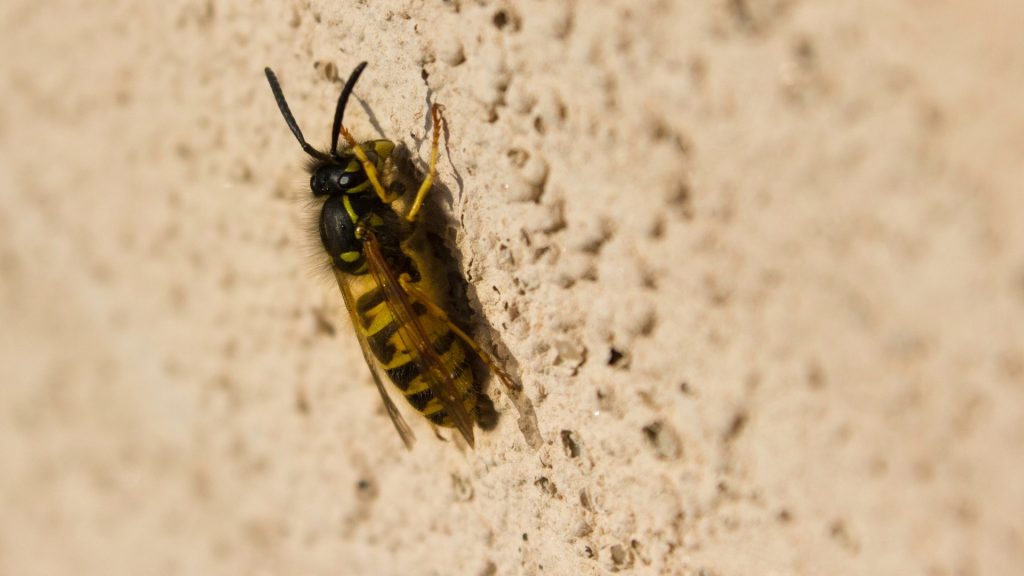
Once yellow jackets have gotten into your walls, you have a more serious problem. Again, you can kill them using similar techniques as siding, except you’ll have to find out in which cavities they have built their nests.
Once you’ve killed them, you have another problem—what to do with the nest. Decomposing wasps can invite scavengers like ants. If yellow jackets got into your walls, you know small insects can find their way.
Even if you locate the hole they use to enter and exiting, their nest might not be anywhere near the opening. To get rid of yellow jackets in your wall, consider consulting with an exterminator for advice.
How To Get Rid of Yellow Jackets in House?
A yellow jacket in the house is more than a mere nuisance. But how do you kill one without having it go after you? Doing so starts with several don’ts.
- Don’t panic and make sudden moves. A startled yellow jacket is likely to stop searching for either food or a way out and defend itself. If you must move, do so slowly.
- Don’t antagonize it. If you spray it with an insecticide or swat at it and miss, you’ll have made at least one enemy.
- Don’t take away the food or drink that has caught its attention. Instead, remove any nearby food and beverages.
Afterwards, you should try the following:
- If it’s an alone yellow jacket, open a window or door and let it find its way out. Remember that they are especially social animals, and most yellow jackets would prefer to be with other yellow jackets instead of being trapped and alone.
- Lure it into a trap with food. Put food or drink inside a resealable jar or soda bottle and wait for the yellow jacket to land. Then, seal the jar and either throw it away or release the yellow jacket away from your house.
Related: How to Get Rid of Wasps in the House? | Information and Facts
How To Get Rid of Yellow Jackets Around the Pool?
No one will have a good time if you don’t get rid of yellow jackets around your pool. They’ll be attracted by the food and drink available. But even if you clean up thoroughly, they’re attracted to the water source, and there’s not much you can do about that, short of draining it.
To get rid of yellow jackets around the pool, you can try the following:
- Make the place something they’ll avoid. Yellow jackets dislike spearmint and thyme, but they really hate wormwood. If they show up every year, consider planting one or both. Just remember that wormwood is extremely poisonous and shouldn’t be consumed. A less permanent solution is cucumber slices covered with aluminum. The reaction gives off a chemical odor yellow jackets don’t like.
- Fool them. Some pool owners have success with using fake nests away from the pool. As a last resort, you can place raw meat away from the pool. However, this is a temporary solution at best since the meat will also attract other insects as well as vermin.
- Trap them. Use traps, either commercial or DIY. If yellow jackets are an annual problem by the pool, combine the traps and some plants to keep them away and kill any that don’t have enough sense to ignore the warnings.
How To Get Rid of Yellow Jackets in the Attic?
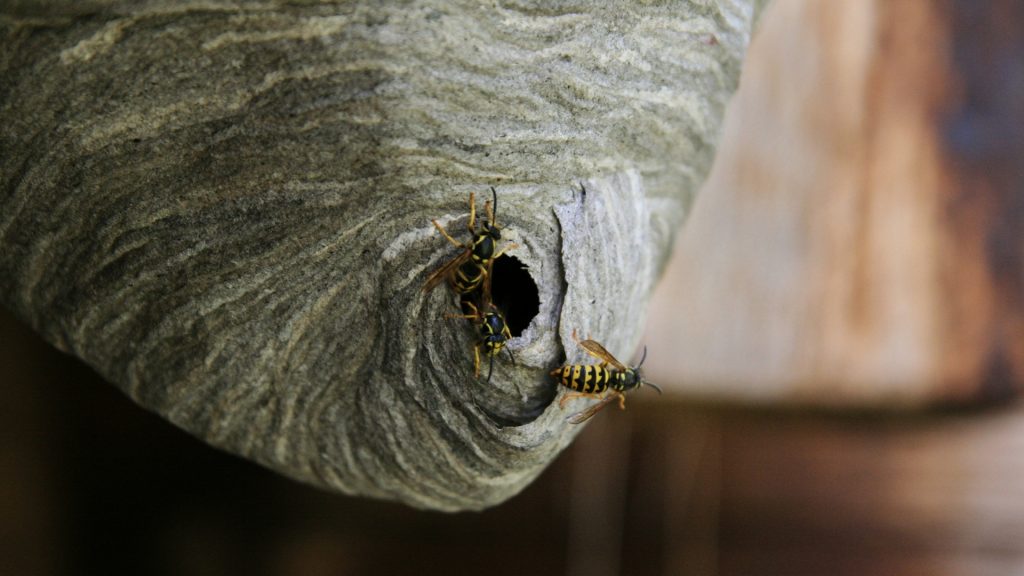
Although active DIYers can eliminate yellow jackets in the attic, doing so carries risks. To get rid of yellow jackets in the attic, here are some methods you can try:
- Use a bee trap. Bee traps contain a sweet, sugary liquid that attracts bees, wasps, and yellow jackets. Once they enter the trap, they drown. The problem with bee traps is that they might bring additional yellow jackets into the attic.
- Use repellents. Repellents can keep them away from you or your children temporarily, but they won’t chase them away permanently. And they could decide to swarm, which you don’t want, especially in an enclosed space.
- Use chemicals. Chemical eradication usually involves removing the nest. Once you locate the nest, you’ll need to clear the area around the nest, secure windows and vents to keep the spray in the attic and spray the nest. Bomb-style poisons work well against nests on the floor, but use sprays with projectile shots for hanging nests.
You’ll need to wear protective clothing while trying to get them out of the attic. Depending on the size of your attic and the nest, consider talking with a professional exterminator.
How To Get Rid of Yellow Jackets Naturally?
Along with planting herbs like thyme, spearmint, and lemongrass or planting wormwood, try hanging scented dryer sheets near your patio to naturally get rid of yellow jackets.
Additionally, consider creating a decoy. Yellow jackets are territorial, so if they see a nest that isn’t theirs, they’ll steer clear of it. You can try these realistic-looking nest decoys to fool yellow jackets:
- Package: 6 paper wasp nest decoys per package are enough for you...
- Size: once propped open, the hanging deterrence nest is about 8 x...
- Stay away from wasps: several species of wasps and hornets will...
- Safe: Just simply hang the fake wasp nest
- Easy to Deploy - Only a few steps to assemble the paper wasp nest...
- PACKAGE - 4 pack yellow paper wasp nest decoy , each hanging wasp...
- EFFECTIVE - Wasps are incredibly territorial small animal, and...
- WHERE TO STRING - We recommend stringing up wasp nest at the edge...
- WHEN TO STRING - We recommended to hang this hornet decoy nest in...
- EASY TO DEPLOY - Only a few steps to assemble the wasp nest...
- 4 pcs Fake Wasp Nest: You will receive 4 pieces fake nests, 4...
- Durable materials: Fake nest is made of cloth fabric upgrade...
- Simple to use:You can decorate wherever you want, convenient to...
- Size: Unfolded size is 8.66 inches in diameter and 11.4 inches...
- Widely Used: You can hang them on eaves, terraces, gardens,...
You can also use a brown paper bag to create a DIY version, but keep in mind that this is not waterproof. So an application of clear acrylic spray will help them resist the elements.
Related: Powerful Homemade Wasp and Bee Sprays (with Recipes)
How To Keep Yellow Jackets Away?
To keep yellow jackets away is a matter of thinking about what attracts them and eliminating that. Here are some tips to keep them from coming to visit:
- Throw away leftover food and keep trash cans tightly sealed.
- The honeydew from aphids is an excellent source of sugar, so if you have an aphid infestation in your yard, you need to control it.
- Leaky faucets and hoses can provide yellow jackets with water, so repair those.
- Avoid brightly colored clothes and perfumes when outside.
How To Make a Yellow Jacket Trap?
To make a simple DIY yellow jacket trap, you need a plastic soda bottle, a sweet liquid, dish soap, and a pair of scissors or knife to cut the soda bottle. Afterwards, follow these simply steps:
- Remove the cap since you won’t be needing it.
- Cut off the top fourth of the bottle. It needs to stay in one piece because you’ll use it as a funnel of sorts.
- Pour enough sweet liquid—sugar water, juice, or soda—to fill half the bottle.
- Add a few drops of dish soap and mix.
- Invert the top of the soda bottle and place it on top, like a funnel. If there are gaps or it doesn’t seem secure, tape it down.
The yellow jackets will be attracted to the sugary water but will struggle to get out due to the thickness of the liquid concoction you’ve created. Eventually, they’ll drown and die.
What Repels Yellow Jackets? Products Review
Yellow jacket sprays, natural repellents, and insecticides can repel yellow jackets. Here are some products from Amazon that you can use:
Best Yellow Jacket Sprays
When looking for yellow jacket sprays, look for products that have pyrethroids, such as cypermethrin or lambda cyhalothrin.
1. Spectracide Ground-Nesting Yellowjacket Killer
No products found.
- Active Ingredients: 0.025% Prallethrin, 0.010% Lambda-Cyhalothrin
- Features: This powerful aerosol is specially formulated for ground-nesting yellow jackets. It comes with an extension tube attachment that allows you to kill on contact and get rid of hard-to-reach wasps deep into their nests.
- How to Use:
- Shake the spray bottle well. Then, attach the extension tube onto the nozzle.
- Spray directly into ground-dwelling yellowjackets. Make sure to point the tube towards the nest and away from the face. For best results, apply during the morning or late in the evening.
- Cover the nest with soil after 24 hours.
2. Spectracide Wasp and Hornet Killer
- INSECTS KILLED: Kills wasps, hornets and yellowjackets, as well...
- UP TO 27 FOOT JET SPRAY: Stand a safe distance from the nest...
- ELIMINATES THE NEST: Wait at least 24 hours before removing...
- POWERFUL SPRAY: Kills insects that return to the nest over the...
- WHEN TO APPLY: Apply at sunset when insects are least active and...
- Active Ingredients: 0.025% Prallethrin, 0.010% Lambda-Cyhalothrin
- Features: This product allows you to eliminate both yellowjackets and hornets on contact and at a safe distance of up to 27 feet. It doesn’t stain any home siding and is made for outdoor use.
- How to Use:
- Shake the spray can before using. Make sure to stand a safe distance from the colony then spray towards the yellowjacket nest.
- Spray until the nest itself is soaked well. After 24 hours have passed, remove the nest.
- For best results, apply at sunset time or when insect activity is at its lowest.
3. Spectracide PRO Wasp & Hornet Killer
- FAST KNOCKDOWN: Kills wasps, hornets, yellow jackets and mud...
- JET SPRAY: This product reaches nests up to 20 feet away
- ELIMINATES THE NEST: SpectracidePRO Wasp & Hornet Killer kills...
- OUTDOOR USE ONLY: Dielectric breakdown voltage of 47,300 volts
- WHEN TO APPLY: Apply at sunrise or sunset when insects are least...
- Active Ingredients: 0.10% Tetramethrin, 0.25% Permethrin, 0.50% Piperonyl Butoxide
- Features: This yellowjacket killer eliminates even pesky insects that return to the nest for up to 4 weeks. It allows you to spray at a safe distance of 20 feet away. Not only that but it is a fast-acting aerosol designed to kill hornets, wasps, and even mud daubers.
- How to Use:
- Shake the spray can well before using. Make sure to perform the application at a safe distance.
- Spray 1 to 2 seconds until the nest is completely soaked. For yellowjackets found indoors, spray until surface is moist.
- After 24 hours, remove the nest.
Best Yellow Jacket Repellents To Buy
Insect repellents aren’t going to kill the yellow jackets, so they’re a temporary solution. However, if you’re headed to a picnic or planning a camping trip, you only need a product that’ll keep them away.
Repel 100 Insect Repellent
- REPELS: Create a barrier against mosquitoes, including those that...
- FORMULATED FOR SEVERE INSECT CONDITIONS: Contains 98.11% DEET for...
- PROTECTS FOR UP TO 10 HOURS: Enjoy the outdoors without the bite...
- ALSO REPELS TICKS, GNATS, BITING FLIES, CHIGGERS & FLEAS: Create...
- PUMP SPRAY: Perfect for outdoor travel – the compact size...
- Active Ingredients: 98.11% DEET
- Features: This repellent can provide protection not only against yellowjackets but other insects such as biting flies, mosquitoes, ticks, fleas, and chiggers for up to 10 hours.
- How to Use:
- Spray on exposed skin, outer surfaces of clothing (including tops of socks and openings).
- Once indoors and away from the dangers of yellowjackets outside, wash sprayed skin with soap and water.
Best Natural Yellow Jacket Repellents
1. EcoSMART Organic Wasp and Hornet Killer
- FRESH SCENT: EcoSmart's Natural Wasp And Hornet Killer works with...
- ENVIRONMENTALLY FRIENDLY: Our plant-based formula eliminates...
- CHILD AND PET FRIENDLY: This product is safe to use around kids...
- NO CHEMICALS: Take chemicals out of your lawn, garden and home...
- MADE IN THE USA
- Active Ingredients: 1% Peppermint Oil, 0.50% 2-Phenethyl Propionate
- Features: This product uses essential oils that attack neurotransmitters in insects that regulate their movement and metabolism, knocking them down and eventually killing them. Therefore, this non-toxic repellent won’t pollute groundwater and is safe for children and pets.
- How to Use:
- Stand at a safe distance from the yellowjacket nest. Make sure to hold the spray can upright and point the nozzle away from yourself.
- Spray until the colony is soaked enough. Repeat if you see any yellowjackets coming out.
- For best results, apply at sunset or sunrise when activity is low. Take note that this product stains any surface.
2. Austin’s Ammonia Multipurpose Cleaner
- Multipurpose cleaner for laundry and general household chores...
- Use full strength, wait a few minute and rinse with clear water
- Can be used on cement floors
- Best for cleaning kitchens, sinks, garbage disposals, and trash...
- Use full strength, wait a few minutes, and rinse with clear water
According to entomologists at the University of Kentucky, you can use an ammonia and water solution (6 ounces or 177.44 mL of ammonia in 1 gallon or 3.79 L of water). Spray it around trash cans and use it to clean outdoor tables.
Best Yellow Jacket Insecticide Dust
Delta Dust Pest Insecticide
- Active Ingredients: 0.05% Deltamethrin
- Features: This product contains long-term residual dust that works quickly on yellow jackets but effectively treats them for up to 8 months. Additionally, it can be applied both indoors and outdoors.
- How to Use:
- Using the duster, apply directly into the entrance of the nest and to its surrounding areas where the wasps can still be found.
- Check the nest 1 to 2 days after the first treatment. Apply more if necessary.
- Lastly, promptly remove and destroy the nest if the yellow jackets are completely eliminated. This prevents the emergence of newly-hatched larvae.
Yellow Jacket Sting Treatment
There are antihistamines and home remedies that you can use to treat yellow jacket stings. However, make sure to consult with your doctor first before using any of these medicine.
How To Treat a Yellow Jacket Sting?
If you don’t have an allergic reaction that requires a trip to the hospital, you can reduce the swelling and pain of the sting.
To treat a yellow jacket sting, first, check if you have an allergic reaction that requires a trip to the hospital. If not, you can use an antihistamine, such as Benadryl, Zyrtec, Claritin, or Allegra, to reduce the effects of the histamine your body naturally produces to protect itself.
- Multi-Symptom Relief: Small coated Benadryl Ultratabs with 25 mg...
- Portable Allergy Medicine: The convenient 100-count bottle fits...
- Versatile Allergy & Cold Relief: Antihistamine tablets...
- Active Ingredient & Age Guidance: Each Benadryl Ultratab contains...
- Value Pack Supply: 100-count package of allergy relief tablets...
- 60-count bottle of Zyrtec 24 Hour Allergy Relief Tablets with...
- This powerful antihistamine contains 10 mg of cetirizine...
- Get effective hay fever& seasonal allergy relief & relief from...
- Suitable for those 6 years of age and older, this allergy symptom...
- These prescription-strength cetirizine HCl allergy medicine...
- INCLUDES: One (1) 60-count pack of Allegra Adult 24-Hour Allergy...
- 24-HOUR RELIEF: Take Allegra antihistamine pill day or night for...
- NON-DROWSY: Formulated with active ingredient fexofenadine, a...
- FAST-ACTING: Allegra 24-hour allergy medicine starts working in...
- INDOOR & OUTDOOR ALLERGIES: Use Allegra gelcaps for outdoor and...
Home Remedies for Yellow Jacket Stings
Several homemade remedies can also help reduce the swelling of yellow jacket stings, including:
- Water and baking soda. Make a paste with baking soda and water and apply it to the bite. The baking soda neutralizes the acid in the venom.
- 2 boxes Value Size 4 lb each total 8 lb = 128 oz total
- America's no 1 trusted baking soda brand
- The standard of purity
- Hundreds of uses
- Meat tenderizer. Meat tenderizer contains papain, an enzyme that helps break down proteins. Apply a paste of tenderizer and water to the bite.
- Unseasoned Meat Tenderizer with Bromelain and Papain
- Papain is the enzyme derived from papaya, while Bromelain is...
- Simply sprinkle the tenderizer directly onto meat, or add a small...
- Use 1 teaspoon per pound of meat. Add powder shortly before...
- Use it on pork, chicken, beef, lamb, and even on seafood such as...
- Vinegar. The astringent qualities of vinegar can help reduce the itchiness of the wound.
- LUCY’S NATURAL COMPOSITION - Lucy’s White Vinegar's...
- SPICING UP DIPPING SAUCES - Lucy’s White Vinegar can add a...
- SUBSTITUTE FOR SALT OR BUTTERMILK - Lucy’s White Vinegar can be...
- ALL-PURPOSE CLEANER - Lucy’s White Vinegar is a powerful,...
- 100% FAMILY OWNED, FOUNDED AND OPERATED - Lucy’s was...
List of Sources
Akre, R. D. et al. (1981). The Yellowjackets of America North of Mexico.
Grissell, E. E., Fasulo, T. R. (1999). Yellowjackets and hornets.
Johnson, K. (2021). Garden tasks to help get your landscape through the summer.
Merchant, M., Pollet, D., Daar, S. T., Drlik, H., Olkowski, W. (n.d.). IPM Action Plan for Yellowjackets.
- Bed Bug Surge 2025: How to Detect, Prevent, and Safely Eliminate Infestations in Top U.S. Cities - June 18, 2025
- Asian Needle Ants Invade US Homes: 2025 Guide to Identification, Risks, and Effective Control - June 11, 2025
- New World Screwworm Alert: How US Livestock Owners Can Prevent Outbreaks and Protect Herds [Summer 2025 Update] - June 8, 2025

